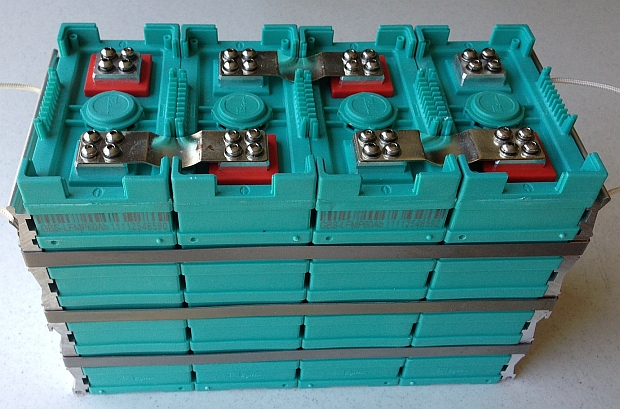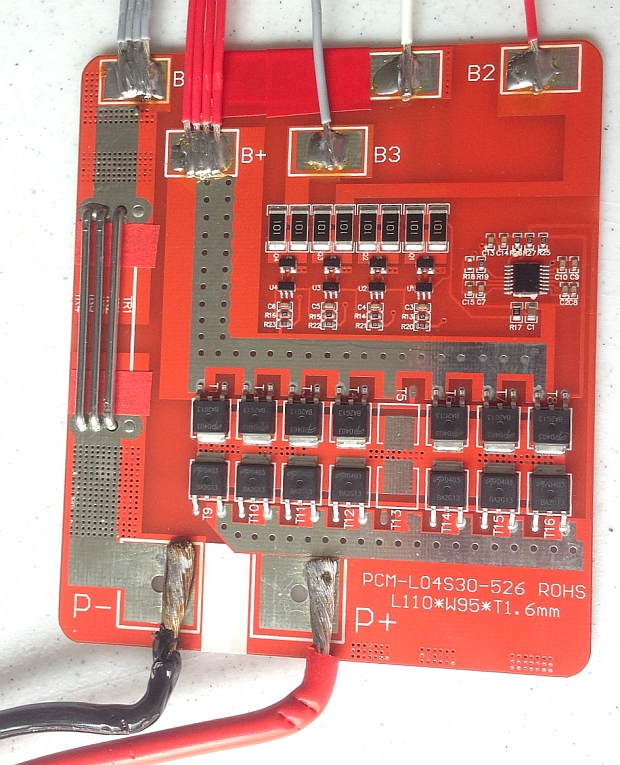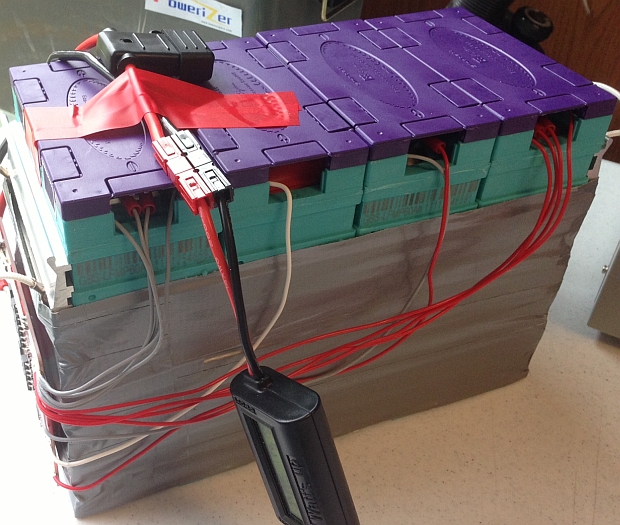After monitoring my K3 power consumption during the SSB WPX Contest, I determined that I could run the K3 continuously set to full power in contest mode for about 30 hours with a 60 AH battery. So my plan is to use a 60 AH battery to power one of the two FD stations this year. The battery is charged by a 100 watt solar panel, so this will also count as an alternative credit as well, but even if the sun doesn’t shine, it should still operate the rig for the entire contest.
I had noted that the price of Prismatic LiFePO4 cells (commercial units used to fabricate heavy duty battery packs for EVs and other high current applications) had been falling substantially. One company had individual cells that had fallen below my threshold of pain, and I was pleased to note that they actually sold set of four, pre-assembled, for even less. So I purchased the set and a Power Control Module (PCM) to use with it.
PCMs come with various functions and ratings, and I acquired one that was rated for 30 amps of charge or discharge current (continuously). In addition, it had full charge and discharge management based on a industry standard 8254 chip. This works by monitoring the voltage of each individual cell and opening the charge path when the battery is fully charged, or by opening the discharge path if the battery is close to the minimum allowable voltage for any individual cell. Seven large FETs are wired in parallel to control the current flow. In addition a balance function makes sure that individual cells remain within +/- 25 millavolts of each other, and will control the flow of charge to individual cells to maintain balance.
Now a 60AH 13ish volt battery is nothing to sneeze at. That’s over 750 watt-hours of energy stored in a small package. If you think 2-slice toaster, you have a good idea of the volume, and it weighs about 20 pounds. But a 60 AH LiFePO4 battery has an advantage of being able to use more than 90% of the stored charge with no damage to the battery. So a 60 AH LiFePO4 battery is more useful than a 100 AH SLA, which can only be discharged to 50% unless you are willing to give up life. Even though the PCM has a 100-150 amp short-circuit disconnect, I decided to add a conventional 25 Amp fuse to the positive lead, which is more than enough to support the full current drain of the K3/P3/KAT500.
The controller board lacks a decent mounting means, and even more surprisingly lacks a good solid mechanical mount for the many conductors that are needed for a high current device. However I was still able to solder the equivalent of 10 AWG by using 4 individual Teflon 18 AWG wires. (I chose Teflon for its abrasion resistance). It will be sandwiched between sheets of vulcanized fiberboard
When it came time to attach the PCM to the battery, I covered all the battery terminals except the one I was working on with electrical tape. I also covered the hex key as well, so only one tip was exposed. (Years ago I worked on a Electric Vehicle and knew how much damage could happen if a tool were dropped while tightening battery connections.) Eventually all the wires (11 of them plus the 10 AWG charge/discharge cable pair) and the battery caps were put back on.
When it came time to test, however, it appeared that the controller chip was keeping the discharge FETs open — I read no output voltage, despite the battery being at about 14.3 volts. I hooked the battery up to my 6 Amp charger, and sure enough current was flowing into the battery, proving that the charge path FETs were conducting. When I removed the charger, the discharge path was working as well. That was enough to get the controller chip back in sync.
A quick 15 minute long discharge test at 10 amps showed a pretty characteristic LiFePO4 discharge curve — it quickly dropped from 14.3 volts down to about 13.5 volts, and took 15 minutes to reach the 13.0 volt point, at which point the curve had become very flat. And this also gave me a chance to prove that there was no significant IR loss in the controller board or wiring, as the total voltage drop between battery terminals and load terminals was about 0.008 volts.
I then put the battery back on the charger and allowed it to run for several hours so the balance circuit would kick in. When the charger was removed, all four cells were within 23 millivolts of each other (worst case).
Further testing will occur over the weekend, when I have the time to run a C/10 (6 Amp) test. But given the initial discharge results, I suspect the battery will have little issue reaching its 60 AH rating.












Where did you purchase the batteries? I have been looking into using LiFePO4 cells to power my FT-857. So far the ones at http://www.batteryspace.com/ have caught most of my attention. -AIØLM
Hi Louis,
BatterySpace.com is where I purchased the parts. I’ve been happy with the end result, especially after testing the unit to confirm it meets the capacity. The importance of a balancing function can’t be overstated, as even a gentle charge (1 amp) of a series string resulted in wildly different individual cell voltages. At the moment I’ve only used a 6 amp charger, but it is balancing better each cycle, and was last around 12 mv different between the lowest and highest cell voltages. 73, Bob, WB4SON
Thanks Bob, I eventually found that out after “reading ahead” a little 🙂
Good to know on the cell balance. I have been looking at building my own charger (I already own a CellPro Multi4 charger) with TI chips (bq24630), but for some reason they don’t have monitors for each cell. To me that is just asking for trouble. -AIØLM